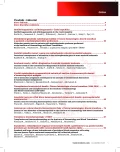-
Medical journals
- Career
Molecular genetic tests in patients with myelodysplastic syndrome performed at the Institute of Haematology and Blood Transfusion
Authors: M. Beličková 1; H. Votavová 1; Čermák J. Za Pracovní Skupinu Pro Mds V Úhkt 1
Authors‘ workplace: Ústav hematologie a krevní transfuze, Praha 1
Published in: Transfuze Hematol. dnes,23, 2017, No. Supplementum1, p. 20-24.
Category:
Pozn: *za pracovní skupinu pro MDS v ÚHKT
Overview
Myelodysplastic syndrome (MDS) is one of the most common haematological diseases occurring after the age of 60 years. Its pathogenesis has not yet been fully elucidated, but with the development of new molecular genetic methods, the molecular background of the disease is being gradually revealed. Determination of cell mono - or poly-clonality may be considered as the first genetic test performed in MDS patients. Subsequent important methods include monitoring of the methylation level of promoter regions in tumour suppressor genes and determination of telomeric-telomerase complex changes. Microarray platforms were brought to the forefront of molecular technologies at the beginning of the 21st century and enabled detection of the expression of thousands of genes simultaneously. At the same time, the role of non-coding RNAs such as miRNA and lncRNA became the focus of great interest. In recent years, revolutionary technology represented by massive parallel sequencing enabling sequencing of the whole human genome in a short time has been introduced. The results of this research, focusing on the study of mutations in various genes, are already being gradually incorporated in the routine molecular screening of MDS patients.
Key words:
myelodysplastic syndrome – molecular genetic methods
Sources
1. Nimer SD. Myelodysplastic syndromes. Blood 2008;111(10):4841–4851.
2. Bennett JM, Catovsky D, Daniel MT, et al. Proposals for the classification of the acute leukaemias. French–American–British (FAB) Co-operative Group. Br J Haematol 1976;33 : 451–458.
3. Arber DA, Orazi A, Hasserjian R, et al. The 2016 revision to the World Health Organization classi fication of myeloid neoplasms and acute leukemia. Blood 2016;127(20):2391–2406.
4. Greenberg PL, Tuechler H, Schanz J, et al. Revised international prognostic scoring system for myelodysplastic syndromes. Blood 2012;120(12):2454–2465.
5. Krejcová H, Neuwirtová R, Cermák J, Belicková M, Brdicka R. Cell clonality inmyelodysplastic syndrome. Sb Lek 2002;103(3):339–348.
6. Cechova H, Lassuthova P, Novakova L, et al. Monitoring of methylationchanges in 9p21 region in patients with myelodysplastic syndromes and acutemyeloid leukemia. Neoplasma 2012;59(2):168–174.
7. Sieglová Z, Zilovcová S, Cermák J, et al. Dynamics oftelomere erosion and its association with genome instability in myelodysplasticsyndromes (MDS) and acute myelogenous leukemia arising from MDS: a marker ofdisease prognosis? Leuk Res 2004;28(10):1013–1021.
8. Vasikova A, Belickova M, Budinska E, Cermak J. A distinct expression ofvarious gene subsets in CD34+ cells from patients with early and advancedmyelodysplastic syndrome. Leuk Res 2010;34(12):1566–1572.
9. Belickova M, Cermak J, Dostalova Merkerova M, et al. Changes associated with lenalidomide treatment in the gene expression profiles of patients with del(5q). Clin Lymphoma Myeloma Leuk 2012;12(5):375–383.
10. Dostalova Merkerova M, Krejcik Z, Votavova H, Belickova M, Vasikova A, Cermak J. Distinctive microRNA expression profiles in CD34+ bone marrow cells frompatients with myelodysplastic syndrome. Eur J Hum Genet 2011;19(3):313–319.
11. Krejčík Z, Beličková M, Hruštincová A, et al. Aberrant expression of the microRNA cluster in 14q32 is associated with del(5q) myelodysplastic syndrome andlenalidomide treatment. Cancer Genet 2015;208(4):156–161.
12. Belickova M, Vesela J, Jonasova A, et al. TP53 mutation variant allele frequency is a potentialpredictor for clinical outcome of patients with lower-risk myelodysplasticsyndromes. Oncotarget 2016;7(24):36266–36279.
13. Jonasova A, Bokorova R, Polak J, et al. High level of full-length cereblon mRNA in lower risk myelodysplastic syndrome with isolated 5q deletion is implicated in the efficacy of lenalidomide. Eur J Haematol 2015;95(1):27–34.
Labels
Haematology Internal medicine Clinical oncology
Article was published inTransfusion and Haematology Today

2017 Issue Supplementum1-
All articles in this issue
- Genetic tests for selecting haematopoietic stem cell donors and post-transplant monitoring
- Centre for rare disorders of haematopoiesis at the Institute of Haematology and Blood Transfusion
- Transfusion and immunohematology at the Institute of Haematology and Blood Transfusion
- Standard and large volume leukapheresis of peripheral blood progenitor cells using the new Spectra Optia continuous mononuclear cell collection protocol
- Dysfibrinogenaemia and afibrinogenaemia in the Czech Republic
- Molecular genetic tests in patients with myelodysplastic syndrome performed at the Institute of Haematology and Blood Transfusion
- Functional consequences of mutations in the nucleophosmin gene in acute myeloid leukaemia
- Current trends in the treatment and diagnostics of chronic myeloid leukaemia
- Use of molecular cytogenetic techniques in the analysis of chromosomal aberrations in haematological malignancies
- Haematopoietic cell transplantation at the Institute of Haematology and Blood Transfusion (1986–2016)
- Transfusion and Haematology Today
- Journal archive
- Current issue
- Online only
- About the journal
Most read in this issue- Dysfibrinogenaemia and afibrinogenaemia in the Czech Republic
- Centre for rare disorders of haematopoiesis at the Institute of Haematology and Blood Transfusion
- Transfusion and immunohematology at the Institute of Haematology and Blood Transfusion
- Functional consequences of mutations in the nucleophosmin gene in acute myeloid leukaemia
Login#ADS_BOTTOM_SCRIPTS#Forgotten passwordEnter the email address that you registered with. We will send you instructions on how to set a new password.
- Career

